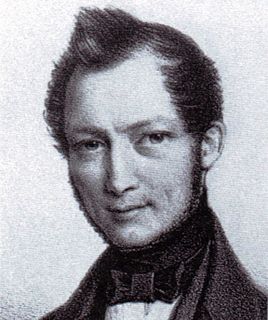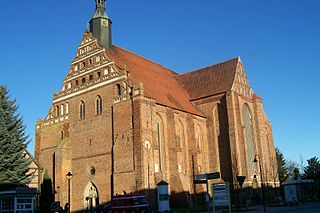 W
WThis article lists the Margraves and Electors of Brandenburg during the period of time that Brandenburg was a constituent state of the Holy Roman Empire.
 W
WBarlinek is a town in Myślibórz County, in West Pomeranian Voivodeship, in northwestern Poland. It is the administrative seat of Gmina Barlinek.
 W
WChorin Abbey is a former Cistercian abbey near the village of Chorin in Brandenburg, Germany. It was founded by the Ascanian margraves in 1258 and had far-reaching influence on the northern edge of the Ascanians' sphere of influence, where it bordered with the Slavs. It was secularized in 1542 and allowed to decay until the early 19th century, when the ruins were restored and the building partly rebuilt under the direction of Karl Friedrich Schinkel. It is now an archetypal example of the Brick Gothic style and part of the Deutsch-Polnisches Klosternetzwerk.
 W
WAdolph Friedrich Johann was a German (Prussian) antiquarian, industrialist and politician, author of Codex diplomaticus Brandenburgensis, a collection of primary documents on the history of the Margraviate of Brandenburg, in 36 volumes.
 W
WThe Eberswalde Hoard or Treasure of Eberswalde is a Bronze Age hoard of 81 gold objects with a total weight of 2.59 kg (83 ozt). The largest prehistoric assembly of gold objects ever found in Germany, it is considered to be one of the most important finds from the Central European Bronze Age. Today, it is in Russia, as part of the group of artifacts and works of art looted from Germany at the end of the Second World War.
 W
WElbe-Elster Land, also called the Elbe-Elster region (Elbe-Elster-Gebiet) is a region around the tripoint of the German states of Brandenburg, Saxony-Anhalt and Saxony. It is part of the North German Plain and is named after the two major rivers that have their confluence here: the Elbe and the Black Elster.
 W
WThe Holy Blood of Wilsnack was the name given to three hosts, which survived a fire in 1383 that burned the church and village to the ground. The hosts were thus seen as miraculous. The relics became the destination of medieval religious pilgrimages to Bad Wilsnack, Germany for nearly two centuries. Revenue from the many pilgrims enabled the town to build the large St. Nicholas' Church at the site. The hosts were destroyed by reformers in 1558 during the Protestant Reformation.
 W
WThe von Plotho family is a German noble family traditionally believed to be of Wendish origin, particularly associated with the Prignitz region in Brandenburg.
 W
WPrussia was a historically prominent German state that originated in 1525 with a duchy centered on the region of Prussia on the southeast coast of the Baltic Sea. It was de facto dissolved by an emergency decree transferring powers of the Prussian government to German Chancellor Franz von Papen in 1932 and de jure by an Allied decree in 1947. For centuries, the House of Hohenzollern ruled Prussia, successfully expanding its size by way of an unusually well-organised and effective army. Prussia, with its capital first in Königsberg and then, when it became the Kingdom of Prussia in 1701, in Berlin, decisively shaped the history of Germany.
 W
WSchloss Tamsel is a significant historical estate in the Brandenburg Neumark region. The estate is located in what is today the small village of Dąbroszyn, Poland, and consists of a manor house, a church and a park. It was constructed in the late 17th century by Field Marshal Hans Adam von Schöning. His granddaughter, Luise Eleonore, inherited the castle as a child of four and married Lieutenant-General von Wreech at age 16.
 W
WThe Teltow and Magdeburg Wars were fought between 1239 and 1245 over possession of Barnim and Teltow in the present-day federal German state of Brandenburg. They took place in the 13th century during the course of the Eastern German Expansion. The opposing sides during the armed conflict, which took place on two fronts simultaneously, were:The Margraviate of Brandenburg, led by the Ascanian rulers John I, Margrave of Brandenburg and Otto III, Margrave of Brandenburg. The Margravate of Meissen, led by Henry III, Margrave of Meissen of the House of Wettin, and Wilbrand von Käfernburg, the then-Archbishop of Magdeburg.
 W
WThe Ukrani or Ukrians were a West Slavic Polabian tribe in the Uckermark from the 6th–12th centuries. Their settlement area was centered on the lakes Oberuckersee and Unteruckersee at the spring of the Uecker River. In this region, burghs with a proto-town suburbium were set up at Drense and on an isle in Lake Oberuckersee.